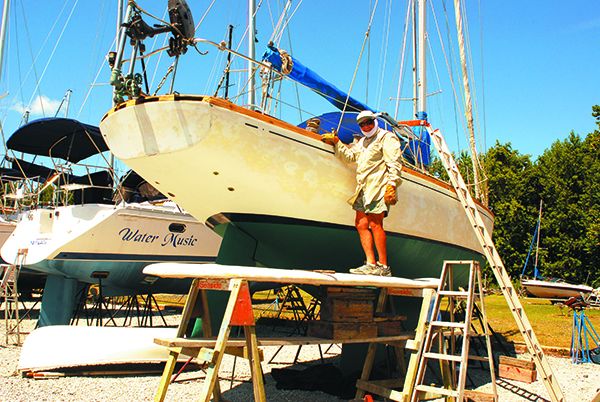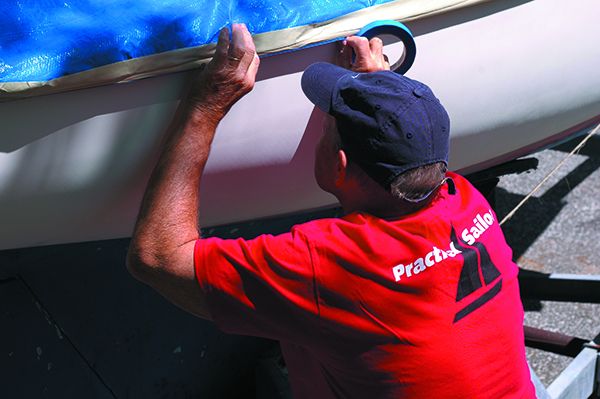
A lot of able, seaworthy, older fiberglass sailboats are falling on hard times. It’s a topic that keeps resurfacing as more and more of these small to midsize sailboats are unable to be sold. It brings to mind a Bill Tripp 31-foot Seafaer sloop that had been moored near Wind Shadow for a couple of decades. The owner of the Dutch built, fiberglass pocket cruiser couldn’t find a buyer, despite his fire sale pricing. Neither family nor friends were interested in the 40-year-old sloop, so her final voyage was off to a fiberglass chipper.
This is becoming an all too often repeated scenario. Older fiberglass sailboats, with solid hulls and sound rigging, are being crushed and scoured for scrap metal. It may be a sequel to the automotive lifecycle, but it’s a sad ending for a seaworthy sailboat.
A closer look at why good boats are being destroyed spotlights a few significant factors. For many, it’s not the price of the boat that’s prohibitive, it’s the “all-up” cost of boat ownership that derails the deal. Topping the list are items such as slip or mooring fees, insurance premiums, haulout and winter storage costs, plus the ever escalating cost of boatyard labor. In just a few years, these expenses can dwarf the purchase price of many good old boats.
But the final nail in the older sailboat coffin is the shift in owner attitude toward maintenance. The do-it-yourself (DIY) attitude is disappearing and the trend among many sailors is to sidelined the toolbox and forego the development of DIY skills in favor of a do-it-for-me (DIFM) approach to maintenance.
More and more boating problems are being solved with a smartphone and a credit card. It’s convenient but there are downsides to the tactic. One big downside is the statement that arrives at the end of each month. The annual cost of this kind of concierge boating is reminiscent of yachting in the mid-1900s, when an owner annually spent at least 10 percent of the yacht’s purchase price on annual maintenance.
Of course, there are times when the expertise of a well-trained, certified ABYC technician is just what’s needed. But there are also plenty of maintenance tasks that a boat owner can handle and take pride in accomplishing. Working on your own boat won’t replace going sailing, but it can deliver some rewards of its own. And as Kenneth Grahame so aptly put it: “There is nothing — absolutely nothing — half so much worth doing as simply messing about in boats.”
I’ve owned Wind Shadow, an Ericson 41, for 45 years and have been a stereotype a do-it-yourselfer, even during the years I managed a full service boatyard.

One of the most important lessons I’ve learned is that fiberglass is a long lived, DIY maintainable material. My affinity for plastic afloat began when I was building surfboards and testing my new designs on glassy, dawn wave faces before it was time to go to school.
This early trial and error experience with turning a liquid polymer into a solid easily transitioned into some boat project skills. Fortunately, the first thing I grasped was some simple safety measures. These measures included avoiding contact with dust, fumes and the caustic nature of hard-to-pronounce chemicals (see PS April 2018, “Staying Safe in the Boatyard”) .
The phrase, “maintenance-free fiberglass,” must have been coined by someone running for office. It’s true in the short term, but eventually acid rain, exhaust particles and other sources of dust and dirt attack the FRP surface.
Properly applied gelcoat is a durable protective coating. And when kindly treated it delivers a decade or more of gloss and protection. Eventually, most gelcoats becomes porous, crazed, and quite pervious. A new paint job, and probably an epoxy barrier coat, can add years of life, but at a cost (see “Epoxy Barrier Coat Update,” PS September 2019). For the owner who is unprepared to take on these projects and reluctant to pay someone else to do it, it may be time to do some soul-searching.
PS contributing editor Ralph Naranjo documented his trans-oceanic voyages with his family during the 1980s in his book “Windshadow West.”































